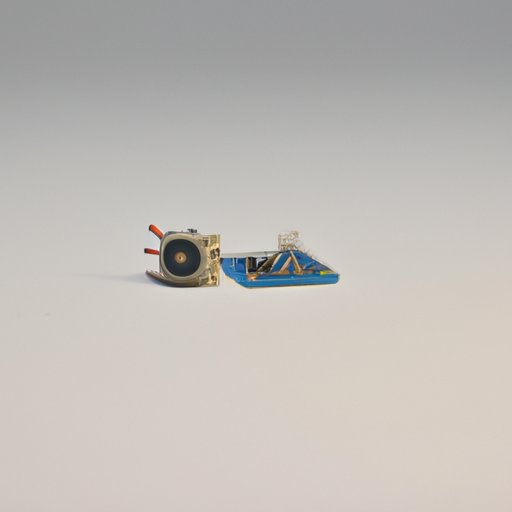Introduction
An accelerometer is a device that measures acceleration, or the rate at which an object’s velocity changes over time. This measurement can be used to determine the speed and direction of a moving object, as well as the force of gravity on an object at rest. Accelerometers are used in a wide range of applications, from robotics projects to automotive and aviation technologies.

Explaining the Science Behind Accelerometers
To understand how an accelerometer works, it’s important to first define what acceleration is. In physics, acceleration is the rate at which an object’s velocity changes over time. This rate can be positive (the object is speeding up) or negative (the object is slowing down).
The principles of Newtonian mechanics form the basis for understanding how accelerometers measure acceleration. According to Newton’s second law of motion, a body will experience an acceleration when a force is applied to it. The magnitude of the acceleration depends on the mass of the body and the strength of the force.
Accelerometers work by measuring the force applied to an object and converting it into an electrical signal. This signal is then processed to calculate the object’s acceleration. Most accelerometers contain a mass suspended on a spring, with a sensing element connected to the mass. As the object moves, the force of acceleration causes the mass to move, which in turn produces an electrical signal. This signal is then amplified and processed to calculate the object’s acceleration.
How to Use an Accelerometer in Robotics Projects
Accelerometers can be used in robotics projects to measure the acceleration of a robot. To do this, you will need several components: an accelerometer, a microcontroller, and some software. The accelerometer is used to measure the acceleration of the robot, while the microcontroller is used to process the data from the accelerometer and control the robot’s movements.
To set up an accelerometer to measure acceleration, you will need to connect it to a power source and configure the settings. Once this is done, you can use the data from the accelerometer to control the robot’s movements. For example, you could use the data to make the robot move faster or slower depending on the acceleration. You can also use the data to detect changes in direction or orientation.
Building a DIY Accelerometer
If you’re looking for a hands-on approach to understanding how an accelerometer works, you can build your own using simple tools and materials. The components you will need include a piezoelectric crystal, a voltage amplifier, a resistive bridge, and some connecting wires. You will also need a soldering iron, solder, and a multimeter.
The steps to construct a DIY accelerometer are fairly straightforward. First, you will need to assemble the resistive bridge and connect it to the piezoelectric crystal. Next, you will need to connect the voltage amplifier and the resistive bridge. Finally, you will need to connect the voltage amplifier to the multimeter and adjust the settings to measure the acceleration.

Comparing Different Types of Accelerometers
There are several different types of accelerometers available, each with its own advantages and disadvantages. Piezoelectric accelerometers are the most common type and are used in a variety of applications. They are relatively inexpensive and easy to use, but they are not very accurate. MEMS (Micro-Electromechanical Systems) accelerometers are more accurate than piezoelectric accelerometers, but they are more expensive and require more power. Capacitive accelerometers are the most accurate type of accelerometer, but they are also the most expensive.
Understanding Accelerometer Measurement Units
Accelerometers measure acceleration in a variety of units, including meters per second squared (m/s2), feet per second squared (ft/s2), and G-forces (g). When working with accelerometers, it’s important to understand the difference between these units and how to convert between them. For example, 1 m/s2 is equal to 9.81 ft/s2 and 0.1019 g.
Examining Real-World Applications of Accelerometers
Accelerometers are used in a variety of real-world applications, from automotive and aviation technologies to gaming systems. In the automotive industry, accelerometers are used to measure the acceleration of vehicles for safety purposes. In aviation, accelerometers are used to measure the movement of aircraft during flight. In gaming, accelerometers are used in motion-sensing controllers to provide a more immersive gaming experience.

Exploring Recent Innovations in Accelerometer Technology
Recent advances in accelerometer technology have enabled smaller, more accurate devices. Miniaturization has allowed accelerometers to be used in small devices such as smartphones and wearables. Digital signal processing has improved the accuracy of accelerometer measurements, making them more reliable. New sensing technologies such as MEMS have also made accelerometers more accurate and efficient.
Conclusion
Accelerometers are used in a variety of applications, from robotics projects to automotive, aviation, and gaming technologies. By understanding the science behind accelerometers and exploring different types of accelerometers, you can gain a better understanding of how they work and how to use them in your own projects. Recent innovations in accelerometer technology have made them smaller, more accurate, and more efficient, enabling them to be used in a wider range of applications.
(Note: Is this article not meeting your expectations? Do you have knowledge or insights to share? Unlock new opportunities and expand your reach by joining our authors team. Click Registration to join us and share your expertise with our readers.)
